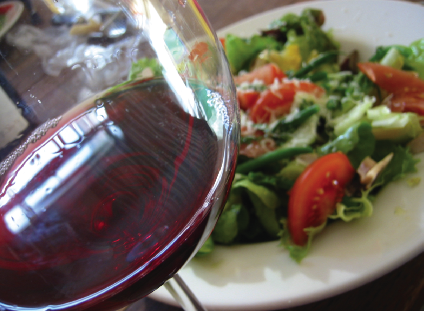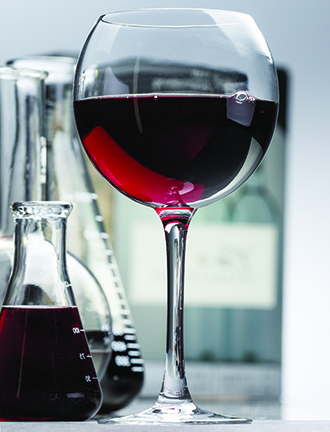
Back in the April-May 2002 issue of WineMaker I wrote an article about picking the right wine kit. The McGuffin of the article was the idea that there was a right kit for every winemaker, based on what time-frame they were looking to drink it in: obviously, if you’re pressed for time, most super-premium wine kits are going to take so long to age that they won’t show well when young. Conversely, the lowest-priced kits are rarely intended for years of tender cellaring before consumption. The article then went on to describe the constituents of the kits (juice, concentrate, etc.) and how they affected ageability.
What was never mentioned in that story, however, was which wines specifically drink better right away. I still want to cover the point of the article that people are actually interested in: what to drink. To tackle this unfinished task, I’m going to divide the story into two parts. In this issue I’ll be discussing “vinfanticide,” which is wines to drink on bottling day (or before). And in the next issue I’ll cover super-early drinking wines (under three months of age).
I know that there are a few kit winemakers reading this column who just got a shocked look on their face: “You can age wine for three months!?!” Honestly, if you have never aged a premium kit for a couple of years, you don’t know what you’re missing. When I talk to folks who say they tried wine kits and didn’t like them, very few ever fully aged the finished wine, and when they do their opinion often changes. But this column isn’t about the benefits of aging, it’s about strategies for getting the most out of wine you’re going to drink insanely young.
There is nothing new under the sun cork
People have been drinking extremely young wine all throughout human history. In fact, it wasn’t until the invention of mass-produced glass bottles and stoppers made from cork that vintage wine, observed to change from year to year and improve with age, became possible on a large scale: all other containers, be they barrels, clay jugs, or the hollowed-out carcass of a large farm animal (I wish I was joking) eventually oxidized or flavored the wine to an extent that made it better to drink it much younger, before the “evil savour” took over.
Another thing: if you’ve been regretting that you don’t have a cellar full of wines that have been aging for many years, you may not be losing out on anything. Most wine experts think that very few commercial wines taste “better” if they are aged more than five years past their vintage date. In many cases, what makes one of those commercial bottles valuable is not that it tastes more divinely perfect with each passing year, but that it becomes more and more rare as most bottles of that vintage get drunk up – the fetish about old wine has a lot more to do with economics than with taste (apart from a few classic exceptions).
On to vinfanticide: Learning from history
Many wine countries have traditions surrounding the consumption of young wine. Perhaps the most famous is the Beaujolais Nouveau, which originated in France and has been widely copied around the world. Based on an excuse to have a whoop-it-up party after the harvest, the festival-like nature of Beaujolais events is a natural for thirsty people eager to get at young wine, which they drink in fairly big glasses, by the bucket-load, along with tasty party food.
The Germans are not to be outdone, however, and their European neighbors the Swiss, Austrians, Slovaks and Georgians are down with wine even younger than Beaujolais. Federweisser is partially fermented, fresh-pressed grape juice. Local variations (and names) apply, but the German word means “white feather” for the light and cloudy appearance that the juice gets from suspended yeast, and it’s generally sold and served between 4 and 10% alcohol by volume. Because it’s actively fermenting it’s sold in jugs with permeable lids (sealed bottles would explode!), and consumed immediately. It’s traditionally served with salty, hearty booze snacks, particularly a dish called Zwiebelkuchen, a kind of onion pizza with bacon and cream (see recipe below). If you’re offered this tasty treat, be warned that the combination of yeasty, still-fermenting wine and incredibly rich, fatty onion pie can have a certain salutary effect on digestion, good as it is.
I think it’s better to think of these as wine events as opposed to wine styles as the original participants always knew full well that they were using a party as an excuse to drink really young wine. The good news is that you can replicate these wines/events with commonly available wine kits. All it takes is a little timing and a wee bit of winemaking finesse.
If you want to try your hand at a Federweisser style
choose a fruity, un-oaked kit. Riesling-based wines are great, but Gewürztraminer, Symphony, Mueller-Thurgau and Viognier will all do very well too. Start the kit as usual, obeying the manufacturer’s instructions, three to four days before you intend to bake up any Zwiebelkuchen. If you start your kits on the warmer side (near 75 °F/24 °C) it will be ready to go in three days, especially if you want a sweeter version. If you start them colder, it could take longer than four or five days to build up proper alcohol content. You’re looking for a drop in the starting gravity of about 0.030–0.40. This will give between 4 and 5% ABV. You can leave it longer, for a drop of 0.050–0.060, for an ABV of 6.5–8%, but if you are waiting until this long, measure the gravity a couple of times a day — it could whip down to dryness overnight and you could miss your window
of opportunity.
When you’re ready to drink, simply siphon off the wine into a serving jug, chill it in the refrigerator for an hour or two and enjoy the zesty, fizzy fruitiness with friends and food. If you’re not prepared to drink 6 gallons (23 L) of partially fermented wine in a two or three day period, you can still have a Federweisser gala, while finishing part of the batch as a normal wine. Calculate the amount you anticipate using, and rack the balance into a clean and sanitized 3- or 5-gallon (11.5- or 19-L) carboy when the gravity has dropped to its proper level, and proceed to make your smaller batch according to manufacturer’s instructions.
If you’d like to try the red version of vinfanticide, one of the manufacturers has a seasonally available kit specifically designed to be produced (and drank) as a Beaujolais Nouveau style. It’s a limited release product, but if you can’t get hold of one, you can still take a crack at enjoying your own Nouveau festival. If your wine shop has a kit labelled “Bergamais,” you’re in luck: manufacturers use this name as a signifier for a Beaujolais-styled Gamay wine. There’s a difference between Beaujolais and Beaujolais Nouveau: the standard style, while meant to drink quite young (a year or so) isn’t the guzzle-fiesta that Nouveau is. All of the regularly available Bergamais kits are the standard style, but you can fiddle with them for fun.
If you can’t find a Bergamais, look for the Gamay variety, or other simple fruity red. Grenache is actually quite good for this, as is Tempranillo and any number of others, but avoid any kit described as “rich” or “intense.” You want a straightforward, fruit-driven red here, not a blockbuster. You’re also shooting for a wine below 13% ABV, so any starting gravity beyond 1.090 is going to give a bit too much alcohol for easy drinking.
The keys to success with making your own Nouveau style are partly winemaking, and partly attitude. For the winemaking, start your kit precisely as the manufacturer’s instructions (as always!) with two exceptions. First, if the kit includes oak, have a look at it: anything beyond an ounce is too much, and anything other than light toast American oak is out of sync with the flavor profile you’re shooting for.
But don’t skip the oak, either. If your kit doesn’t include any oak, get an ounce of the aforementioned light-toast American chips or powder and include it in the primary fermenter. Oak helps cover a multitude of sins, including greenness, tartness and harshness. American oak typically has sweet notes of vanilla, and light toast keeps the smoky character out of the mix.
Second, once the must is prepared and the oak is in, have a look at your yeast pack. Actually a good time to have a look at your yeast pack would have been before you stirred up the concentrate, because there are a couple of yeasts available that can make a big difference in the flavor of your Nouveau-style. Lalvin 71-B is a great choice in dried yeast, with excellent fruit development, and is often cited for Nouveau making. If you’re comfortable using a liquid yeast, Wyeast Chateau Red is a very good choice as well, bringing out the bright fruit of Gamay wines. The yeast strains commonly included in kits will work just fine, but EC1118 or Red Star Premier Cuvée don’t always develop the maximum of fruity young flavors that Nouveau would benefit from.
With the oak and yeast in hand, proceed with all other kit operations as normal. Stick to the four- or six-week production schedule in your instructions, and on bottling day, as soon as the wine is clear, throw a party and start drinking it.
This is where the attitude comes in: Beaujolais Nouveau is extremely fruity and often slightly fizzy. If you didn’t get all of the CO2 out in processing, this is the one time where it is actually a benefit. It’s also meant to be drunk lightly chilled, at perhaps 55–60 °F (13–15 °C) out of beer mugs, jelly glasses or an old coffee cup, with tasty, salty party food and a light-hearted attitude. Invite over a dozen of your best friends, roast a few chickens and lay out some cheese, sausage, bread and other savory snacks, put Edith Piaf or Serge Gainesbourg on the stereo and pull on a beret. Et Voila!
If you don’t manage to drink all 6 gallons (23 L) of your Nouveau-style in one night, don’t despair. It will continue to display fresh and fruity flavors for a couple of months, and after that it will begin to drink in the style of a Beaujolais Village — simple, light and fruity, which is not such a bad thing either!
Onwards
Next issue we’ll discuss which whites and reds drink well immediately after getting over bottle shock and which wines are just naturally better very young. In the meantime, when was the last time you had a really good piece of onion pie?
Zwiebelkuchen
Ingredients
6 pounds (2.7 kg) onions, thinly sliced
4 slices bacon
1 (16 ounce/454 g) container sour cream
4 eggs, lightly beaten
2 tablespoons all-purpose flour
1⁄2 teaspoon salt
1⁄2 teaspoon grated nutmeg
Pastry for a 9-inch (23-cm) single crust pie
Directions
1. Preheat oven to 425 °F (220 °C). Line a tart pan
or large pizza pan with prepared dough, making
sure it extends up sides of pan.
2. Dice bacon and fry in a skillet until almost crisp.
Remove bacon and retain grease in the pan. Sauté
onions in the bacon grease until translucent and fully
cooked.
3. In a large mixing bowl mix onions, bacon and sour
cream. Add lightly beaten eggs and flour and salt.
Mix well and pour into prepared crust. Sprinkle top
with nutmeg.
4. Bake in preheated oven for about 1 hour, when
onions start to turn golden brown on top.






